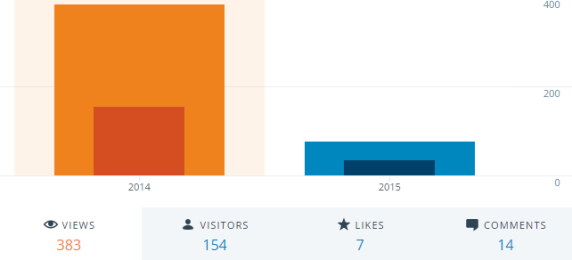So many drafts, yet such inconsistent publishing.
Time after time
My experience of writing in public is one of self-consciousness — whip-creamed with “Is this right?” and sprinkled with “I feel like I have no idea”. It’s not as though this is new to me — just check out that menu bar! I’m also well aware that there is no correct way, but the criticism I have for my own writing is a definite barrier to consistency.
Student blogging
My understanding of ‘student blogging’ is that it is a task. That fact itself influences my lenient attitude towards this blog. I’d imagine blogging to be less pressuring — but not necessarily ‘simpler’ — if it were, say, a hobby. There’s something about things feeling like a ‘task’ that don’t particularly motivate me to complete them.
Regardless of work ethic, writing in public presents an opportunity for collaborative learning. Ellison & Wu (2008) consider blogging a means of opinionated exchange and negotiation of meaning. These aspects of collaborative learning aren’t necessarily fostered in other writing assignments — the typical ‘major essay’ assessment for example doesn’t quite allow for peer input.

Blogging may be an individual task, but it can foster collaborative thought. (source)
Possibly the greatest benefit of collaborative learning is the encouragement it can generate. I find others’ positive reviews a pleasurable read. It indicates at least the slightest interest in my work, even if expressed with exaggerated praise. Ellison & Wu find that this kind of activity and the response it generates leads the student to spend more time doing other course-related activities. Investing more time in reading course material and attending classes obviously results in better grades and student satisfaction.
Through the mirror of my mind
Using public writing for research communication
Public writing has been a way of reflecting. I can reflect by responding to feedback, comparing with fellow public writers and referring to previously published communications research. This has become a platform for building experience and questioning the effectiveness of my research practices. With each new communications subject I take (that menu is definitely going to get longer), progress can be recorded by myself and seen by others.
“Information technology skills” sounds clever on a résumé. The experience applies beyond academia. According to DiBiase (2002), the benefits of e-portfolios have more to do with their development than the end product. DiBiase lists the following potential opportunities provided by public writing (p. 10):
- increased learning effectiveness
- modelling professionalism (in writing, not fashion)
- enhancing information technology skills
- gaining academic credit for learning beyond the classroom
Finding my voice
While still self-conscious about it, my writing has become a lot smoother.
My preferred style is much clearer to me. The type of personality I want to portray online — which is definitely different to that of my offline profile — is both casual and somewhat professional. Well, enough to get hired, maybe.
Kim et al. (2011) study the differences between offline and online identities. It is argued that it takes less time and effort to establish an online identity — there are no physical self-defining barriers. Things like race and age are self-characteristics which can be hidden in an online identity.
In this way, public writing provides a very open platform for self-expression.
(All the tears) All the tears
While my writing has improved, I haven’t quite established a comfortable online identity. There’s no particular aspect of my offline life that I’d like to share online — what would be of interest to other people? If I knew, I’d undertake this platform further than simply a ‘university blog’. What would the ‘genre’ of my blog be — or could there be several genres in one?
A regular audience would help to clarify this.
Building an audience
The engagement between me and an audience is just about non-existent on this blog.
This is the aspect of public writing I’ve definitely struggled with most — maintaining attention… of others. The biggest audience interaction I’ve experienced was from last year (2014) — that was through BCM110 — in which commenting on others’ posts was compulsory.
In that period of blogging, I received a burst of attention in my first few weeks. But, my online identity was very vague: my introductory post spoke about my liking of pistachios — it has since been deleted.
Although I’ve published the same number of posts this year, my promotional efforts have been poor. This probably comes back to my lack of consistency in publishing (attributable to my lack of organisation, which is also reflected here). I promise you, prospective employer, I’m not that terrible.
I keep holding on
Goals
This blog needs to be more than an ‘assessment’. That means crafting and publishing my overwhelming collection of drafts. It would also really help if I established a greater presence in other online spaces — Twitter especially. Creating this presence and building my consistency will help my writing to flourish. Hopefully then I will see a cycle of audience interaction, encouragement, and continued writing.

This could be me, but I’m playin’. (source)
References:
DiBiase, D 2002, ‘Using e-portfolios at Penn State to enhance student learning: Status, prospects, and strategies’, Penn State University, viewed 05 October 2015, <https://www.e-education.psu.edu/files/e-port_report.pdf>.
Ellison, N & Wu, Y 2008, ‘Blogging in the Classroom: A Preliminary Exploration of Student Attitudes and Impact on Comprehension’, Journal of Educational Multimedia and Hypermedia, vol. 17, no. 1, pp. 99-122.
http://genius.com/Diana-ross-and-the-supremes-reflections-lyrics
Kim, HW Zheng JR & Gupta S 2011, ‘Examining knowledge contribution from the perspective of an online identity in blogging communities’, Computers in Human Behaviour, vol 27, no. 5, pp. 1760-1770


